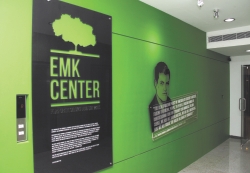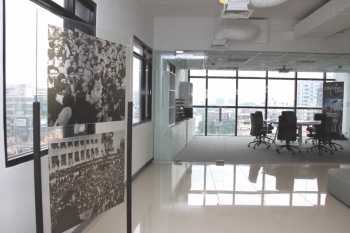| Home - Back Issues - The Team - Contact Us |
 |
| Volume 11 |Issue 29| July 20, 2012 | |
|
|
Event Under the Banyan Tree Equipped with iPads and painted seductively in white, Edward M Kennedy Center for Public Service and the Arts is going to be a crowd puller in Dhanmandi Ahmede Hussain "The real foreign policy of America is citizen to citizen, friend to friend, people to people, foreign bonds of brotherhood that no tyranny can diminish. For in a sense we are all Bangladeshis, we all share the great alliance of humanity." Banyan is not a mere tree in this part of the world. Besides having the resilience to withstand cyclones and other disasters, both natural and manmade, this enormous tree–if untouched–lives for hundreds of years. Banyan is also firmly rooted in the soil it is planted in, and under its soothing shadow people rest, make parley and set up bazaars where new friendships grow, businesses develop, and the seed of prosperity is sown. In villages, theatre troops make rounds during the winter to set up makeshift stalls where people light a fire, huddle together or watch a jatra or pala until a sublime, white light descends from the heavens to declare the breaking of a new dawn–all under the banyan tree. If you need a tree to symbolise the resilience and diversity of the peoples of the sub-continent, banyan it has to be.
It is a small wonder that when in 1972 Edward Kennedy thought of giving something to Bangladesh, a country's liberation he relentlessly fought for through his activism, he chose a banyan sapling. Only a year ago, Ted, as the charismatic senator from Massachusetts was fondly called, had been the Senate Majority Whip, and the citizens of the United States knew him for authoring more than 300 bills that were later made into law. Bangladeshis adore him for a different reason altogether. During the country's independence war, for the freedom fighters, Ted Kennedy, along with the ordinary US citizens, had remained the tower of strength. The Lion of the Senate flew to refugee camps, condemned atrocities of the Pakistan army and submitted his report to the US Senate. Rekindled by Kennedy's spirit, US dockworkers at the Philadelphia seaport had put up a human barrier protesting shipment of arms to Pakistan. The banyan sapling that Senator Kennedy had planted has a symbolic value. It replaced a banyan tree that was destroyed by the occupying forces, signifying a rejuvenation of the sprit of freedom, which ordinary men and women of both the countries proudly share. Kennedy's tree now stands tall in Dhaka, and so is Bangladesh-US friendship. And come September, the tree is going to have a metaphoric comeback in the form of the logo of the Edward M Kennedy Center ((EMK) for Public Service and the Arts. Funded by the State Department and nestled quietly on the 9th floor of the Midas Centre in Dhanmandi, the EMK Center is going to have iPads, reference books, DVDs, and current US magazines. "Visitors will also be allowed to bring their own laptops so that they can access the free wifi," says MK Aref, director of the centre, "There's going to be a multi-media auditorium, an adda zone, a study area, classrooms and a café." All for a nominal membership fee of Tk 1,000, which includes access to the American Center's lending library as well as Education USA student advising programme.
Aref says that the centre wants to promote dialogue, community engagement and artistic development. He thinks the centre will be able to engage, inspire, connect, and empower citizens of all ages to better themselves, their communities and the world. It is dedicated to public service and arts, he says. The idea of public service in the US is a curious one. American Center Director Lauren Lovelace says that the American idea of public service includes all types of service that is practised every day by conscientious citizens: teachers, engineers, community service volunteers, writers, artists–all have the potential to be public servants. The centre is also the by-product of a partnership between the Liberation War Museum and the American Center of the US Embassy Dhaka. “We are honoured to partner with the Liberation War Museum and to join with them in building a space that remembers US Senator Kennedy and the longstanding friendship between Bangladeshis and Americans," Lovelace says, "We are also inspired by the work and the vision of young Bangladeshis and we hope that this centre will be an institutional resource that grows with them.” Akku Chowdhury, trustee of Liberation War Museum, echoes Lovelace's view. He thinks that the desire to be free is integral to the spirit of freedom, which connects the citizens of Bangladesh with their US counterparts and that Bangladesh and US's independence war drew strength from the same source. Chowdhury hopes that through this initiative a new leadership will emerge to take us to the future. "It is the youth that takes us to the future, to the new dream that we the freedom fighters had, the people of the world have… This is the space where our future generation, our future leaders, will see what the world is. It's an awakening," he says. The EMK Center is poised to become a hub for young people in Dhanmandi and the adjoining areas. The centre, in collaboration of renowned US universities, can launch a lecture series where artistes, philosophers and academicians can share their worldview with Bangladeshi youths through video conference or online chat. It can also bring in original paintings of master American painters such as Mark Rothko, Jackson Pollock and Andy Warhol. A guided tour through webcam into the heart of Museum of Modern Art will quench the thirst of local art connoisseurs. Or imagine a live conference with Peter Eisenman where he talks about 'House VI' or 'Memorial to the Murdered Jews of Europe', arguably two of his most illustrious projects, with Bangladeshi architecture students. Speaking of culture, the US has a lot to give us, and it should not shy away from doing it. The EMK Center is warmly painted in white; inside, it is cool and spacious, as inviting as a public place should be. As you walk in, a kiosk showcasing Bangladesh's liberation war will catch your eye. And of course there will be the legend, Ted Kennedy, planting the banyan sapling or giving his famous speech where he reaffirmed his belief in our shared destiny, his faith in the invincibility of the spirit of freedom. Do drop by if you happen to live in Dhanmandi or an area nearby. For you, the EMK Center is going to be the window on the world; you will certainly want to get a glimpse. EMK Center for Public Service and the Arts
|
||||||||||
|


